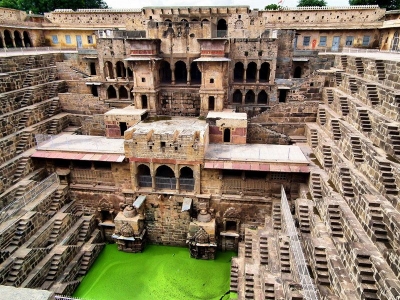
What is a stepwell?
As the name suggests, a stepwell is a pond or well with water that can be reached by descending a series of steps. It is mostly mutli-storeyed and can be found across western India.
Stepwells are prime examples of irrigation and storage tanks built to quench the thirst of the people during parched summers. They are mostly dug deep down to collect the seepage of an upstream lake or reservoir. This is why most stepwells are underground. The reason these are built with steps is to make it easier for people to access groundwater and to maintain and manage the well.
Most stepwells are intricately carved with several sculptures. Apart from serving as a well, they serve as a cool retreat during summers.
Rani-ki-Vav
Rani ki-Vav or the Queen’s Stepwell is located in the town of Patan in Gujarat India. Situated on the banks of the river Saraswati, this stepwell was built in the 11th century AD. During the rule of the Chalukya dynasty it was constructed in menton of King Bhimdev I by his widowed wife. Queen Udayamati Prabandha Chintamani, composed by the Jain monk Menunga Suri in 1304 AD makes a reference to the construction of this stepwell by Queen Udayamati.
Built near the Saraswati, this stepwell was once completely floosted by the river and silted over till the 1940s. This is when the site was rediscovered by people. In the 1980s, the Archaeological Survey of India (ASI) excavated the site and restored it from 1981 to 1987. An image of Queen Udayamati was also recovered during the excavation
Rani-ki-Vav was declared a Monument of National Importance and protected by the ASI. It was included in the UNESCO list of World Heritage Sites in 2014,
Architecture
The stepwell is built in the Maru Gurjara architectural style in the form of an inverted temple with seven levels of stairs and over 500 main sculptures, It is approximately 64m long, 20m wide and 27m deep
Most of the sculptures found here are devoted to Lord Vishnu in his ten forms. There are also sculptures dedicated to the Buddha
As mentioned before this stepwell is designed like an inverted temple to highlight the sanctity of water. The steps begin at the ground level and you have to go down seven pillared pavilions to reach the well below. At water level there is a caning of Seshashayi Vishnu – the avatar where he rests on his thousand hooted serpent Sesha. The well is present in the western most part of the complex.
Picture credit : Google

